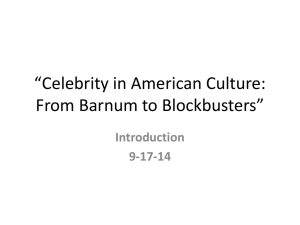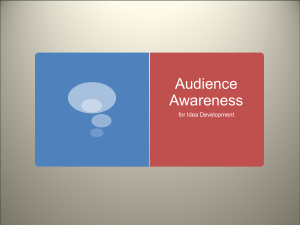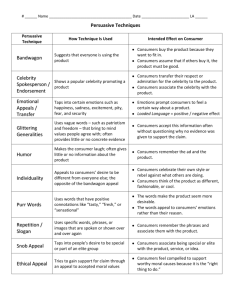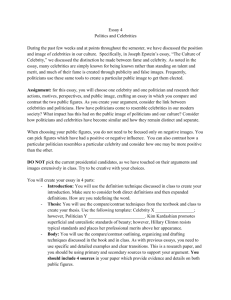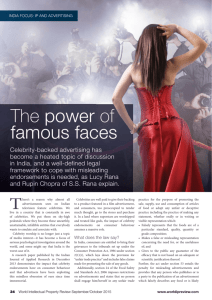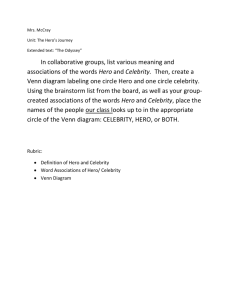Does the Use of Celebrities Make Advertising More Effective?
advertisement
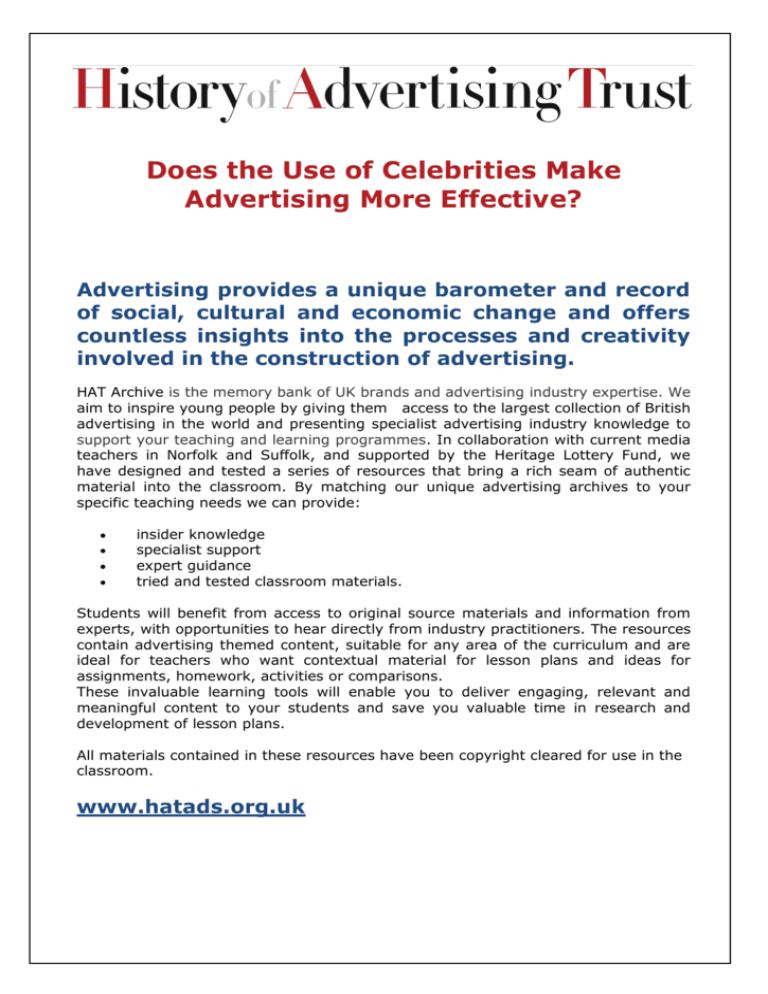
Does the Use of Celebrities Make Advertising More Effective? Advertising provides a unique barometer and record of social, cultural and economic change and offers countless insights into the processes and creativity involved in the construction of advertising. HAT Archive is the memory bank of UK brands and advertising industry expertise. We aim to inspire young people by giving them access to the largest collection of British advertising in the world and presenting specialist advertising industry knowledge to support your teaching and learning programmes. In collaboration with current media teachers in Norfolk and Suffolk, and supported by the Heritage Lottery Fund, we have designed and tested a series of resources that bring a rich seam of authentic material into the classroom. By matching our unique advertising archives to your specific teaching needs we can provide: insider knowledge specialist support expert guidance tried and tested classroom materials. Students will benefit from access to original source materials and information from experts, with opportunities to hear directly from industry practitioners. The resources contain advertising themed content, suitable for any area of the curriculum and are ideal for teachers who want contextual material for lesson plans and ideas for assignments, homework, activities or comparisons. These invaluable learning tools will enable you to deliver engaging, relevant and meaningful content to your students and save you valuable time in research and development of lesson plans. All materials contained in these resources have been copyright cleared for use in the classroom. www.hatads.org.uk Does the Use of Celebrities Make Advertising More Effective? There’s no doubt that having celebrity backing can increase brand awareness and bestow desirable qualities upon a product. But there are downsides - hiring a celebrity comes with a monetary cost, the risk of embarrassment and over-exposure. So what about using an unknown? In an age where reality television is dominating the ratings, the line between celebrity and the average boy/girl next door is increasingly blurred. And the trend carries over into advertising where matching the person to the product and the target audience seems to be the most important factor. image and reputation to maintain, their alliance with a brand tells the consumer The upsurge of sporting icons, film stars that the company is reputable and and music idols endorsing and advertising trustworthy. brands in recent years, and their influence on consumer purchasing, is well Marks and Spencer recently announced a documented. There’s no doubt that revamp of its celebrity advertising line up having celebrity backing can bestow and one of those dropped was Twiggy. particular qualities upon a product that it But M&S obviously didn’t want to sever all might otherwise lack. An advertisement ties whilst Twiggy was such a popular featuring a celebrity will capture attention advocate of a large part of their and increase awareness of a brand and demographic: it was later announced that thus benefit sales. It also gives out a the former model was to launch her own persuasive message – the celebrity is collection for the retailer. seen to be benefitting from the product and, the inference is, so will the 2012 Twiggy unveils own collection for consumer. M&S 1. The Cult of Celebrity The presence of the celebrity enhances a brand’s distinctive identity. Although it cannot intrinsically improve any of the product’s features or performance, it can provide added value and credibility. An infusion of celebrity attention can rejuvenate a stagnant brand; it can also compensate for a lack of inventive marketing ideas. Approval of a brand by a celebrity fosters confidence and highlights brand awareness in a cluttered marketplace. Also, because the celebrity has an The use of a suitable celebrity can be a powerful tool in a campaign, although their presence alone will not guarantee success. A good advertising idea linked with a suitable celebrity is a must-have for a successful campaign. On the other hand, use of the same celebrity in advertisements for several different products dilutes the endorsement and leads to over-exposure. And these days consumers understand advertising; they know how it works. They realise that Does the Use of Celebrities Make Advertising More Effective? The cult of celebrity (continued) celebrities are paid huge sums of money for their endorsements; if the media picks up on a signing, generating more free publicity for the celebrity and the product, it’s no surprise that the public are cynical. But there are downsides. Hiring a celebrity comes with a monetary cost, the risk of embarrassment and possible over-exposure. Underneath all the razzamatazz, celebrities are just like the rest of us: flesh and blood subject to the same stresses and temptations, and a brand’s image and reputation can be damaged if the celebrity behaves badly or says something detrimental in an unguarded moment. Kate Moss was famously dumped by a series of major brands during her cocaine exposé and Jane Horrocks put her foot in it when she announced that she didn’t shop in Tesco as there were ‘rather a lot of chavs in’, even though she was happy to admit that the ads she starred in had paid for her house. 2011 Jane Horrocks Tesco ads Advertisers hoping to avert potential damage to their brands are quick to distance themselves from a misbehaving celebrity but recent research suggests that while such incidents might change consumers’ buying choices, this is only a temporary phenomenon, with the majority returning to their previous purchasing patterns over a period of time. The suggestion is that consumers are generally unperturbed by a celebrity’s indiscretions and they have less impact on purchasing behaviour than advertisers suppose, possibly because the British public are more forgiving, having become blasé about public scandal over the years. This would seem to be borne out by the Kate Moss experience: two years after her fall from grace, she was courted by the fashion giant TopShop and has since become the face of the high street. A celebrity can also be too closely associated with a particular product for comfort. The BBC recently complained about a Virgin Media ad featuring David Tennant, on the premise that references to Dr Who in the ad suggested the Corporation’s endorsement of the TiVo service. 2012 Virgin Media pulls David Tennant ads Hamish Pringle, former General Director of the Institute of Practitioners in Advertising (IPA) explains how harnessing star power can enhance a brand: http://www.thedrum.com/ opinion/2014/09/01/how-brands-shoulduse-celebrities-build-their-business Does the Use of Celebrities Make Advertising More Effective? 2. Celebrity Endorsement So, is the tide turning? There is a definite move towards a different kind of celebrity endorsement, where the famous are seen actually using products – snapped on the street nonchalantly toting a particular handbag, or wearing a designer’s clothes – which does more to promote the desirability of the product than any number of magazine or TV advertisements. This tactic of endorsement, where an advertiser pays a celebrity to appear casually with a product, indicating that it is a part of their daily life, is common in the luxury market; it’s effective because it portrays a real lifestyle which the public can relate and aspire to. There’s an interesting comparison to be made between products and the type of celebrity used to endorse them. Products such as household insurance, mobile phone services and weed killer are routinely advertised by home grown celebrities – those who appear weekly on our screens in soap operas and dramas. More aspirational, though not necessarily more expensive products, such as cosmetics, sunglasses and designer underwear use film stars and celebrities with a much higher profile. Ultimately, the most successful campaigns fit the celebrity to the brand. The celebrity must appeal to the target audience and have personal attributes that reflect the appeal of the brand. The But there’s still room for luck - a celebrity celebrity must also be credible as a user walking down the street innocently of the product, so that consumers can drinking from a bottle of your branded make the link between ‘her off mineral water is the best kind of publicity Eastenders’ with a specific product. – and it’s free. Does the Use of Celebrities Make Advertising More Effective? 3. Celebrity or Real Person? In an age where reality television is dominating the ratings, the line between celebrity and the average boy/girl next door is increasingly blurred. And the trend carries over into advertising. But how does a brand determine whether a celebrity would work better than a real person in their campaign? 2011 Rimmel - Kate Moss 2011 L’Oreal - Cheryl Cole 2002 Gillette - David Beckham As we’ve seen, there are positives in using a celebrity. They are more effective at attracting publicity and the product gains from association with role models that the consumer wants to emulate. But a brand can suffer from a celebrity’s indiscretions and the message can be undermined by over-exposure. So what about using an unknown? Real people will be much cheaper and they can be more successful and persuasive when used to advertise products that require an amount of social approval. Consumers ask the opinion of friends and family before buying, leading to the conclusion that testimonials from real people matter. But a real person will not be as experienced at delivering a message, nor will they appear on the gossip pages or be as glamorous or recognizable to the public. Matching the person to the product and the target audience seems to be the most important factor. Does the Use of Celebrities Make Advertising More Effective? In October 2010 IKEA launched a 60second commercial on ITV during “The X Factor” ad break, presenting a new version of Jona Lewie’s 1980s hit “You’ll always find me in the kitchen at parties”. The new version of the 80′s hit was performed by the up-and-coming UK group Man Like Me and remixed by Arthur Baker. The band and Jona Lewie appear in the video. Paul Whitehouse, the comic, has been the main focus of Aviva commercials in the last few years in which he plays a number of comic characters in different situations. For example, the football supporter taking his companions to away games, an elderly Welsh 'goth' who collects antiques, and a deceased father figure providing life insurance to his grieving family. 2010 Ikea - Kitchen Party 2010 Aviva - Silver Surfer 4. Ideas for your classroom Get your students to find examples of advertising using celebrities and examine their impact. Pay particular attention to the matching of the celebrity with the product. Are the celebrities intrinsic to the message, or incidental? Would the message be any different if the celebrity was replaced with a real person? Does the calibre of a celebrity have an influence on the message? Or the sales? Find examples of advertisements where the featured celebrity has had a subsequent fall from grace. Ask if this had a noticeable effect on the popularity of the celebrity themselves. And on the brand. Get your students to choose a product and create their own advertising campaign around a real person, not a celebrity. They must research their target audience and give reasons for using this particular person. Does the use of an unknown make any difference to the message? Discuss when a celebrity endorsement is more effective than a full-scale advertising campaign. Does the Use of Celebrities Make Advertising More Effective? Links The images and commercials used in this resource have been selected to illustrate the main points of the text. However, you can also visit HAT’s Arrows website, the site offers the opportunity to search and view over 25,000 TV commercials dating from 1977 to the present day. The commercials on Arrows are all submissions and award winners from British Arrows (formerly the British Television Advertising Awards). You can select, create and store online up to twenty commercials within your own customised show reel for use in the classroom. Digital advertising images and TV commercial footage can be supplied by HAT on almost any theme at reasonable prices. You may wish to browse through HAT’s online galleries for more ideas and inspiration. Copyright This course is written and produced by the History of Advertising Trust and is licensed for use in a classroom context only. Terms and conditions can be found here: HAT copyright statement
